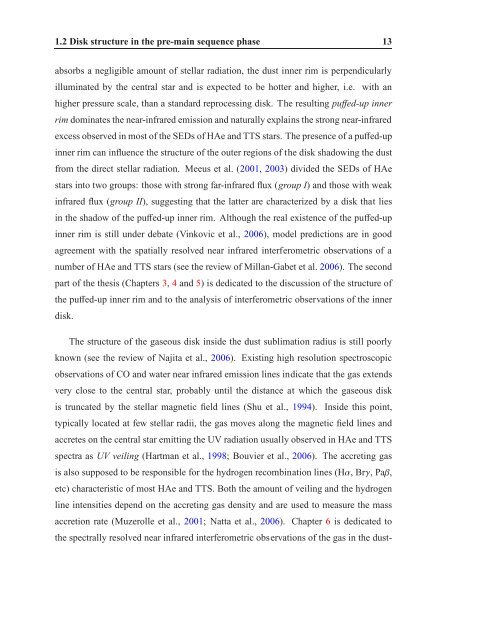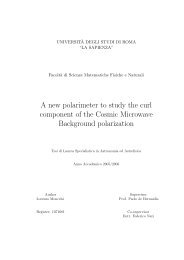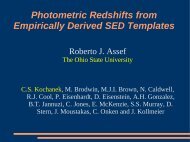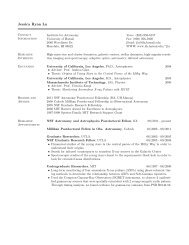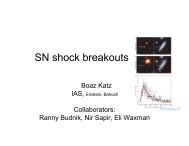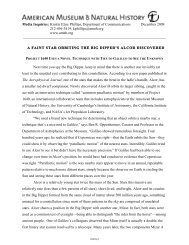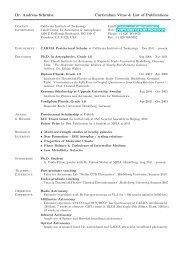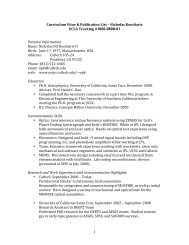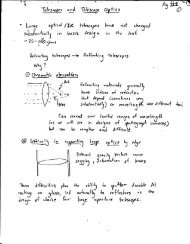Interferometric observations of pre-main sequence disks - Caltech ...
Interferometric observations of pre-main sequence disks - Caltech ...
Interferometric observations of pre-main sequence disks - Caltech ...
You also want an ePaper? Increase the reach of your titles
YUMPU automatically turns print PDFs into web optimized ePapers that Google loves.
1.2 Disk structure in the <strong>pre</strong>-<strong>main</strong> <strong>sequence</strong> phase 13<br />
absorbs a negligible amount <strong>of</strong> stellar radiation, the dust inner rim is perpendicularly<br />
illuminated by the central star and is expected to be hotter and higher, i.e. with an<br />
higher <strong>pre</strong>ssure scale, than a standard reprocessing disk. The resulting puffed-up inner<br />
rim dominates the near-infrared emission and naturally explains the strong near-infrared<br />
excess observed in most <strong>of</strong> the SEDs <strong>of</strong> HAe and TTS stars. The <strong>pre</strong>sence <strong>of</strong> a puffed-up<br />
inner rim can influence the structure <strong>of</strong> the outer regions <strong>of</strong> the disk shadowing the dust<br />
from the direct stellar radiation. Meeus et al. (2001, 2003) divided the SEDs <strong>of</strong> HAe<br />
stars into two groups: those with strong far-infrared flux (group I) and those with weak<br />
infrared flux (group II), suggesting that the latter are characterized by a disk that lies<br />
in the shadow <strong>of</strong> the puffed-up inner rim. Although the real existence <strong>of</strong> the puffed-up<br />
inner rim is still under debate (Vinkovic et al., 2006), model <strong>pre</strong>dictions are in good<br />
agreement with the spatially resolved near infrared interferometric <strong>observations</strong> <strong>of</strong> a<br />
number <strong>of</strong> HAe and TTS stars (see the review <strong>of</strong> Millan-Gabet et al. 2006). The second<br />
part <strong>of</strong> the thesis (Chapters 3, 4 and 5) is dedicated to the discussion <strong>of</strong> the structure <strong>of</strong><br />
the puffed-up inner rim and to the analysis <strong>of</strong> interferometric <strong>observations</strong> <strong>of</strong> the inner<br />
disk.<br />
The structure <strong>of</strong> the gaseous disk inside the dust sublimation radius is still poorly<br />
known (see the review <strong>of</strong> Najita et al., 2006). Existing high resolution spectroscopic<br />
<strong>observations</strong> <strong>of</strong> CO and water near infrared emission lines indicate that the gas extends<br />
very close to the central star, probably until the distance at which the gaseous disk<br />
is truncated by the stellar magnetic field lines (Shu et al., 1994). Inside this point,<br />
typically located at few stellar radii, the gas moves along the magnetic field lines and<br />
accretes on the central star emitting the UV radiation usually observed in HAe and TTS<br />
spectra as UV veiling (Hartman et al., 1998; Bouvier et al., 2006). The accreting gas<br />
is also supposed to be responsible for the hydrogen recombination lines (Hα, Brγ, Paβ,<br />
etc) characteristic <strong>of</strong> most HAe and TTS. Both the amount <strong>of</strong> veiling and the hydrogen<br />
line intensities depend on the accreting gas density and are used to measure the mass<br />
accretion rate (Muzerolle et al., 2001; Natta et al., 2006). Chapter 6 is dedicated to<br />
the spectrally resolved near infrared interferometric <strong>observations</strong> <strong>of</strong> the gas in the dust-


